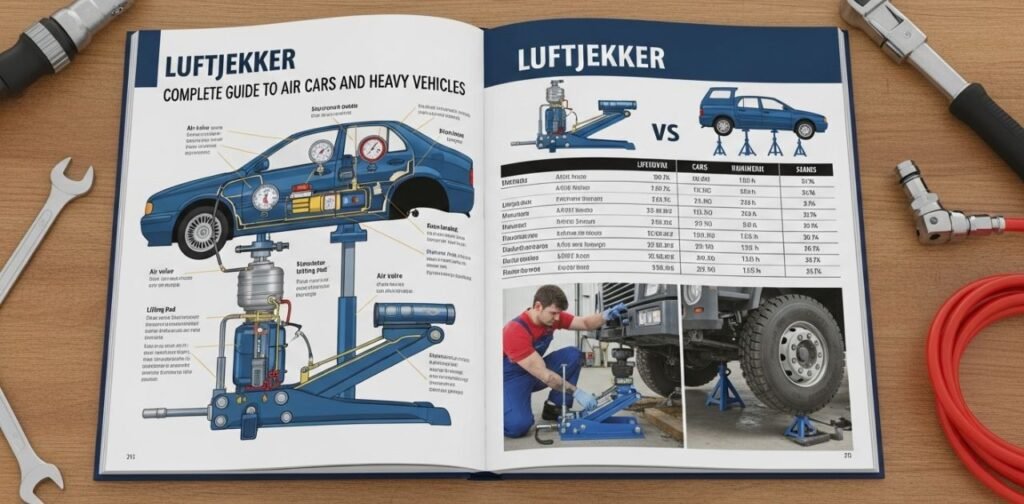Introduction
In the automotive world, safety and efficiency are everything. Whether you are a professional mechanic, a workshop owner, or a car enthusiast who enjoys DIY repairs, the right tools can make all the difference. One such essential tool is the Luftjekker, often referred to as an air jack. Unlike traditional hydraulic or scissor jacks, the Luftjekker uses compressed air to lift vehicles quickly, safely, and with minimal effort.
The popularity of Luftjekker has grown because it combines speed, convenience, and durability. Mechanics appreciate how fast it lifts cars, while everyday users find it safer compared to older manual jacks. If you frequently work on vehicles, whether small cars or heavy-duty trucks, investing in a Luftjekker can completely transform your maintenance routine.
In this detailed guide, we’ll explore what a Luftjekker is, how it works, its advantages over conventional jacks, buying tips, best practices, and answers to the most frequently asked questions.
What is a Luftjekker and How Does it Work?
A Luftjekker is a lifting device that uses compressed air to raise vehicles off the ground. It typically consists of a sturdy base, an inflatable airbag (made from reinforced rubber), and a valve system connected to an air compressor. When compressed air flows into the jack, the airbag inflates and lifts the vehicle within seconds.
This system is very different from hydraulic jacks or scissor jacks. Hydraulic jacks rely on pumping action and oil pressure, while scissor jacks use manual turning of a screw mechanism. Both take time and physical effort, and they can be unstable if not used correctly.
The Luftjekker, on the other hand, requires almost no physical strength. Once connected to an air compressor, it can lift vehicles ranging from small passenger cars to SUVs and even light trucks. Most models have a lifting capacity of 2 to 5 tons, making them suitable for garages, workshops, and roadside assistance services.
The working principle is simple but powerful: compressed air = quick lifting. It’s reliable, consistent, and ideal for situations where speed and safety are priorities.
Advantages of Using a Luftjekker Over Traditional Jacks
There are many reasons why professionals and car owners prefer a Luftjekker instead of traditional lifting devices. Here are the biggest advantages:
- Speed and Efficiency – A Luftjekker can lift a car in less than 10 seconds. Compare this to manual jacks that require continuous pumping or turning.
- Safety – With a wide base and low center of gravity, air jacks provide excellent stability. The inflatable bag spreads pressure evenly, reducing the risk of slipping.
- Ease of Use – Minimal effort is required. Simply connect to an air compressor, position under the car, and let the jack do the work.
- Durability – Most Luftjekkers are made with heavy-duty rubber and steel components, designed to withstand thousands of lifting cycles.
- Versatility – Suitable for cars, vans, SUVs, and light trucks. Many models can even handle vehicles with low clearance where traditional jacks struggle.
- Reduced Wear and Tear – Since there are no complicated moving parts like pistons or gears, maintenance is easier and long-term reliability is higher.
For workshops handling multiple vehicles daily, the time saved per job makes a huge difference. For private users, the added safety and convenience make the Luftjekker a smart investment.
How to Use a Luftjekker Safely and Effectively
Although a Luftjekker is safer than traditional jacks, proper usage is still essential. Here’s a step-by-step guide:
- Preparation
- Park the car on a flat surface.
- Engage the parking brake.
- Place wheel chocks behind the tires.
- Positioning the Jack
- Locate the vehicle’s recommended lifting points (check the owner’s manual).
- Slide the Luftjekker under the correct spot.
- Connecting the Air Supply
- Attach the jack to a compressed air line.
- Ensure the valve and hose are secure before operation.
- Lifting the Vehicle
- Open the valve to allow compressed air into the bag.
- Monitor the lift carefully—most vehicles reach full height within 5–10 seconds.
- Securing the Vehicle
- Always use jack stands for long-term work.
- Never rely solely on the Luftjekker when working under the vehicle.
- Lowering the Vehicle
- Release air slowly using the valve.
- Ensure the vehicle settles evenly back on the ground.
By following these steps, you can ensure maximum safety while enjoying the speed and convenience of the Luftjekker.
Choosing the Right Luftjekker: Buying Guide
Not all air jacks are created equal. When shopping for a Luftjekker, here are key factors to consider:
- Lifting Capacity – Choose a jack that can safely handle the weight of your vehicle. For most cars, 2 tons is enough, but for SUVs and trucks, look for 3–5 tons.
- Lifting Height – Check the maximum height the jack can reach. Taller lifts are better for maintenance jobs like tire changes or suspension work.
- Build Quality – Look for heavy-duty rubber bags reinforced with multiple layers, along with a strong steel base.
- Portability – If you need to carry it for roadside assistance, choose a compact and lightweight model.
- Ease of Connection – A simple, leak-proof valve system ensures smoother operation.
- Brand Reputation – Trusted brands offer better reliability and after-sales support.
Investing in a high-quality Luftjekker means fewer breakdowns, safer usage, and long-term value. Cheap models may save money upfront but can be risky under heavy loads.
Best Practices for Maintenance and Longevity
To keep your Luftjekker in top condition, follow these maintenance tips:
- Regular Inspections – Check the rubber bag for cracks or wear.
- Cleanliness – Wipe off dust, oil, and debris after each use.
- Air Pressure Checks – Ensure your compressor delivers clean, dry air at the recommended pressure.
- Storage – Keep in a cool, dry place away from sharp objects.
- Avoid Overloading – Never exceed the rated lifting capacity.
With proper care, a Luftjekker can last many years and remain just as reliable as the first day you used it.
Frequently Asked Questions (FAQs)
1. What vehicles can a Luftjekker lift?
Most models can lift cars, SUVs, vans, and light trucks, depending on their tonnage capacity.
2. Do I need a special compressor for a Luftjekker?
No, most standard air compressors work fine, as long as they deliver the required PSI.
3. Is it safe to use a Luftjekker on uneven ground?
It’s not recommended. Always use the jack on a flat, stable surface to avoid accidents.
4. How fast can a Luftjekker lift a car?
Usually within 5 to 10 seconds, depending on vehicle weight and compressor power.
5. Can I use a Luftjekker without jack stands?
For very short tasks like tire replacement, it’s possible, but for safety reasons, jack stands are always advised.
6. How much does a Luftjekker cost?
Prices vary from budget models around $100 to professional-grade versions costing $500 or more.
7. Are Luftjekkers durable?
Yes, with proper care, they are extremely durable. Many professional garages use them daily for years.
Conclusion
The Luftjekker is a game-changer in vehicle lifting technology. By replacing slow, labor-intensive hydraulic and scissor jacks, it brings speed, safety, and convenience to workshops and private garages alike. From quick tire changes to full-scale maintenance, this tool saves time and reduces effort, making it a must-have for professionals and serious car enthusiasts.
Looking ahead, we may even see digital Luftjekkers with built-in pressure sensors, automatic safety locks, and smart features for extra precision. But even in its current form, the Luftjekker remains one of the most efficient tools for vehicle lifting.
If you want reliability, ease of use, and professional-level performance, a Luftjekker is one of the best investments you can make for your automotive toolkit.



